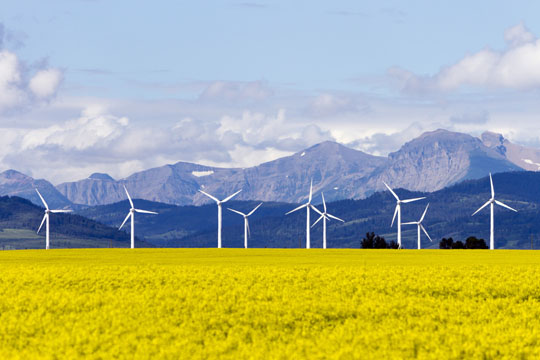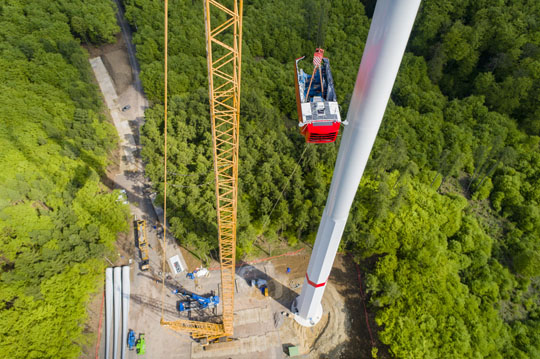Plotting the wind
Freiburg, Sep 14, 2018
Wind energy is an important pillar of Germany’s energy transition. The German government aims to meet 65 percent of the country’s energy needs with solar, hydroelectric and biomass-produced power by 2030. In their latest study, Dr. Christopher Jung and Dr. Dirk Schindler at the University of Freiburg show that 40 percent of current energy needs could be met by wind energy alone by the year 2030. The main requirement is for energy providers to achieve an optimal distribution of wind turbines across Germany.
 Turning point: The German government aims to produce 65 percent of its energy from wind and hydroelectric power and from biofuels by 2030.
Turning point: The German government aims to produce 65 percent of its energy from wind and hydroelectric power and from biofuels by 2030.
Photo: sakkmesterke/Fotolia
Wind turbines are a sensitive issue. The former premier of Baden-Württemberg Erwin Teufel once warned against allowing wind turbines to “shoot up” all over the Black Forest. The German government appears to have overcome that fear and is planning more wind turbines. Yet in pursuit of the 2030 goal, Germany’s existing 28,675 turbines did not perform well enough. Local governments in Baden-Württemberg are searching desperately for new locations. It sometimes happens that turbines are built in places which are politically acceptable - but which do not promise an efficient yield. “If we fail to use wind energy optimally, we will have to install more wind turbines than necessary in the High Black Forest,” says Dirk Schindler of the Chair of Environmental Meteorology.
He and his colleague Christopher Jung have developed a computer model which depicts the full range of options: Wind speeds, terrain surface and turbine size are only some of the varying, interacting factors which they have programmed into their computer. The researchers’ model enables decision-makers to search objectively for good locations, spreading the net wide. “We are looking for the most efficient way of achieving the objective,” Christopher Jung explains.
 Strong winds are not restricted to flat regions like Germany’s north. Freiburg researchers have shown that wind turbines could also produce good yields in mountainous parts of a country. Photo: nalidsa/Fotolia
Strong winds are not restricted to flat regions like Germany’s north. Freiburg researchers have shown that wind turbines could also produce good yields in mountainous parts of a country. Photo: nalidsa/Fotolia
Locations in the south
If it were decided purely on wind speeds recorded by the 400 weather stations maintained by the German Weather Service across the country, the picture would be clear: The usual winds in Europe are westerly and southwesterly - and they blow strongest in north-western Germany, where there are no hills to slow them down. So you could pack the landscape around Bremen and Hamburg with enough turbines to meet the whole country’s energy needs by 2030. The would not have to be especially big. But that wouldn’t be fair. Nor would it really be necessary. “There are plenty of places in the south with enough exposure to give a high yield,” Schindler says.
The two researchers have identified the locations across Germany. The many red spots on the Freiburg regional map show what is possible. Even the Schönberg would be a good spot for a turbine. Jung admits that “not everything with a good yield is feasible.” The more efficiently the wind energy is used, the fewer turbines will be needed. After all, we don’t want to change the landscape more than necessary. The various scenarios change depending on whether there is meant to be an even distribution according to states or even districts. In Baden-Württemberg it would be the mid-range hills which would bear the brunt, while the areas protected by them, like Upper Swabia, would be excused. They could still do their bit, but they would have to put up more turbines.
 A wind turbine must deliver maximal yields - for that, the old installations need to be replaced with new, technically better ones. Photo: Peter/Fotolia
A wind turbine must deliver maximal yields - for that, the old installations need to be replaced with new, technically better ones. Photo: Peter/Fotolia
Replace old turbines
What characterizes a good location? To find out, the two researchers combined the wind speeds from all 400 weather stations with precise details of the features of the respective terrain. The weather station at the Freiburg airfield, for example, is located on a green sward at the edge of the apron, 238 meters above sea level, surrounded by flat land and the town to the east. Landscape features largely determine whether the wind is slowed down or speeded up. From all this data, the computer model analyzed the most efficient locations across all of Germany and can even calculate the altitude - for instance, above the treetops in the Black Forest - which will have the highest energy yield.
It is not new locations along which will help Germany achieve its energy policy goal. “We have to use the existing locations better,” Dirk Schindler says, pointing to “the technical advances of recent years, which have led to much more efficient wind turbines.” Obsolete turbines should be replaced by new ones in as many locations as possible, he adds. Jung and Schindler have included 50 different scenarios in their model, each with slightly different variables. In their best-case scenario, a total of 36,000 turbines are sufficient to meet the target. The worst-case scenario needs 80,000.
The public are unlikely to be convinced that wind energy makes sense if they see rotors sitting still all the time. The two Freiburg researchers believe acceptance will increase if the benefits are there for all to see.
Anita Rüffer

